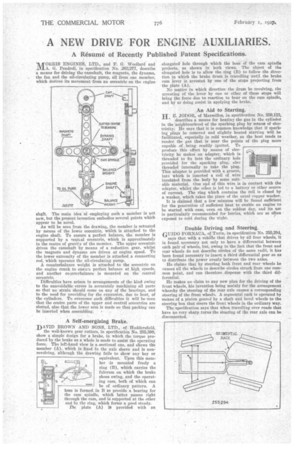A NEW DRIVE FOR ENGINE AUXILIARIES.
Page 66

If you've noticed an error in this article please click here to report it so we can fix it.
A Résumé of Recently Published Patent Specifications.
Mil-ORRIS ENGINES, LTD., and F. G. WooHard and .13'.1.A. G. Pendrell, in specification No. .283,277, describe a means for driving the camshaft, the magneto, the dynamo, the fan and the oil-circulating pump, all from one member, which derives its movement from an eccentric on the engine
shaft. The main idea of employing such a member is not new, but the present invention embodies several points which appear to be novel.
As will be seen from the drawing, the member is actuated by means of the lower eccentric, which is attached to the engine shaft. To ensure a perfect balance, the member is supported by a eential eccentric, which is approximately in the centre of gravity of the member. The upper eccentric drives the camshaft by means of a reduction gear, whilst the magneto and dynamo are driven at engine speed. to the lower extremity of the member is attached a connecting rod, which operates the oil-circulating pump.
A counterbalance weight is attached to the eccentric on the engine crank to enstra perfect balance at high speeds, and another counterbalance is mounted on the central eccentric.
Difficulties have arisen in arrangements of the kind owing to the unavoidable errors in accurately machining all parts so that no strain should come on any of the bearings, and to the need for providing for the expansion, due to heat, of the cylinders. To overcome such difficulties it will be seen that the centre parts of the upper and central eccentrics are slotted, also that the lower arm is made so that packing can be inserted when assembling. •
A Self-energizing Brake.
DAVID BROWN AND SONS, LTD., of Huddersfield, the well-known gear cutters, in specification No. 255,599, show a simple design for a brake, in which the torque produced by the brake as a whole is made to assist the operating force. The left-hand view is a sectional one, and shows the member. (A), which is fixed to the axle sleeve and is nonrevolving, although the drawing fails to show any key or equivalent. Upon this member is mounted freely a ring (B), which carries the fulcrum on which the brake shoes swing, and the operating cam, both of which can be of ordinary pattern, A boss is formed in B to provide a bearing for the cam spindle, which latter passes right through the cam, and is supported at the other end by the ring, which forms a good steady. rhc plate (A) Le provided with an elongated hole through which the boss of the cam spindle projects, as shown in both views. The object of the elongated hole is to allow the ring (B) to follow the direction in which the brake drum is travelling until the brake cam lever is arrested by one of the stops projecting from the plate (A). No matter in which direction the drum be revolving, the arresting of the lever by one or other of these stops will bring the force due to reaction to bear on the cam spindle, and by so doing ossist in applying the brake.
An Aid to Starting. H E. JODOR, of Marseilles, in specification No. 259,123, .describes a means for heating the gas in the cylinder in the neighbourhood of the sparking plug by means of electricity. He says that it is common knowledge that if sparking plugs be removed and slightly heated starting will be facilitated, especially in cold weather, as the heat tends to render the gas that is near the points of the plug more capable of being readily ignited. To produce this effect by , means of electricity he makes an adapter, which is threaded to fix into the ordinary hole provided for the sparking plug, also threaded internally to take the plug. This adapter is provided with a groove, into which is inserted a coil of wire insulated from the body by some suitable material. One end of this wire is in contact with the adapter, whilst the other is led to a battery or other source of current. The ring which contains the coil is closed by a washer, which takes the place of the usual copper washer.
It is claimed that a few minutes will be found sufficient for the generation cf sufficient heat to enable an engine to be started with ease, even on the coldest day, and its use is particularly recommended for lorries, which are so often exposed to cold during the night.
259123
Double Driving and Steering.
GUIDO FORNACA, of Turin, in. specification No. 255,294,
says that with a vehiMe that drives by all four wheels, it is found necessary not only to have a differential between each pair of wheels, but, owing to the fact that the front and rear wheels do not describe circles of the same radii, it has been found necessary to insert a third differential gear so as to distribute the power evenly between the two axles.
He claims that by steering both front and rear wheels he causes all the wheels to describe circles struck from one common point, and can therefore dispense with the third differential.
He makes no claim to any new plan for the driving of the front wheels, his invention being mainly for the arrangement whereby the steering of the rear axle causes a corresponding steering of the front wheels. A segmental rack is operated by means of a pinion geared by a shaft and bevel wheels to the steering box that steers the front wheels in the ordinary way.
The specification says that when travelling over roads that have no very sharp turns the steering of the rear axle can be disconnected.


































































































